China-Australia Free Trade Agreement: Impact on Businesses & Law
VerifiedAdded on 2023/05/29
|18
|5650
|385
Essay
AI Summary
This essay provides an in-depth analysis of the China-Australia Free Trade Agreement (ChAFTA), examining its background, objectives, and policies. It assesses both the positive and negative impacts of ChAFTA on Australian and Chinese businesses, focusing on its influence on Australian goods exporters and service suppliers. The essay also explores opportunities for investors, provisions for consumers, and strategies for businesses to effectively manage the agreement. Key outcomes, such as increased trade volume and investment, are highlighted, along with the competitive advantages gained by Australia in sectors like agriculture. The essay concludes by summarizing the overall benefits and challenges presented by ChAFTA, underscoring its significance in fostering economic growth and trade relations between the two nations.

Chinese Trade and Investment Law
China and Australia Free Trade Agreement (ChAFTA)
China and Australia Free Trade Agreement (ChAFTA)
Paraphrase This Document
Need a fresh take? Get an instant paraphrase of this document with our AI Paraphraser

Abstract
The aim of this essay is to evaluate ChAFTA and its positive and negative impact on
Australian and Chinese businesses. This essay will address the impact of ChAFTA on Australia
goods exports and service suppliers to understand how it creates trading opportunities for
them. This essay evaluated the background of ChAFTA and an overview to understand its
impact on the economic growth of the countries and evaluate how businesses can manage
this agreement. This topic is selected because this is a significant agreement which supports
the growth of Australian economy and it provides various trading opportunities to
Australian businesses.
Page 1
The aim of this essay is to evaluate ChAFTA and its positive and negative impact on
Australian and Chinese businesses. This essay will address the impact of ChAFTA on Australia
goods exports and service suppliers to understand how it creates trading opportunities for
them. This essay evaluated the background of ChAFTA and an overview to understand its
impact on the economic growth of the countries and evaluate how businesses can manage
this agreement. This topic is selected because this is a significant agreement which supports
the growth of Australian economy and it provides various trading opportunities to
Australian businesses.
Page 1

Table of Contents
Introduction...............................................................................................................................3
Background................................................................................................................................4
Objectives of ChAFTA.................................................................................................................5
Overview of policies and outcomes of ChAFTA.........................................................................6
Benefits of ChAFTA.....................................................................................................................7
Negative of ChAFTA....................................................................................................................8
Impact on Australian Goods Exporters......................................................................................8
Agriculture sector...................................................................................................................9
Energy sector..........................................................................................................................9
Impact on Australian service suppliers....................................................................................10
Opportunities for investors..................................................................................................11
Provisions for Australian consumers and businesses..........................................................13
How businesses can manage this agreement..........................................................................13
Conclusion................................................................................................................................14
Bibliography.............................................................................................................................15
Page 2
Introduction...............................................................................................................................3
Background................................................................................................................................4
Objectives of ChAFTA.................................................................................................................5
Overview of policies and outcomes of ChAFTA.........................................................................6
Benefits of ChAFTA.....................................................................................................................7
Negative of ChAFTA....................................................................................................................8
Impact on Australian Goods Exporters......................................................................................8
Agriculture sector...................................................................................................................9
Energy sector..........................................................................................................................9
Impact on Australian service suppliers....................................................................................10
Opportunities for investors..................................................................................................11
Provisions for Australian consumers and businesses..........................................................13
How businesses can manage this agreement..........................................................................13
Conclusion................................................................................................................................14
Bibliography.............................................................................................................................15
Page 2
⊘ This is a preview!⊘
Do you want full access?
Subscribe today to unlock all pages.

Trusted by 1+ million students worldwide
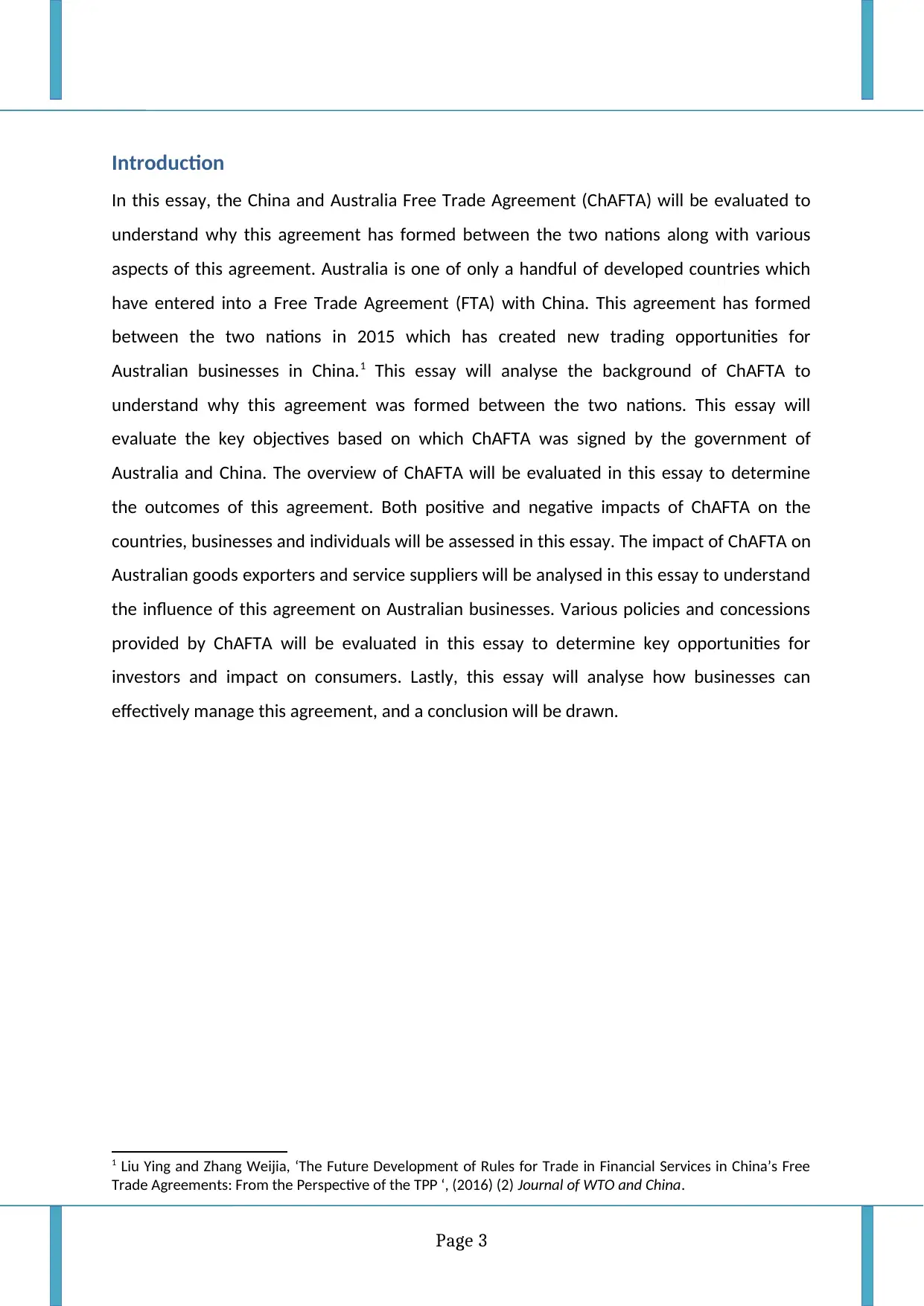
Introduction
In this essay, the China and Australia Free Trade Agreement (ChAFTA) will be evaluated to
understand why this agreement has formed between the two nations along with various
aspects of this agreement. Australia is one of only a handful of developed countries which
have entered into a Free Trade Agreement (FTA) with China. This agreement has formed
between the two nations in 2015 which has created new trading opportunities for
Australian businesses in China.1 This essay will analyse the background of ChAFTA to
understand why this agreement was formed between the two nations. This essay will
evaluate the key objectives based on which ChAFTA was signed by the government of
Australia and China. The overview of ChAFTA will be evaluated in this essay to determine
the outcomes of this agreement. Both positive and negative impacts of ChAFTA on the
countries, businesses and individuals will be assessed in this essay. The impact of ChAFTA on
Australian goods exporters and service suppliers will be analysed in this essay to understand
the influence of this agreement on Australian businesses. Various policies and concessions
provided by ChAFTA will be evaluated in this essay to determine key opportunities for
investors and impact on consumers. Lastly, this essay will analyse how businesses can
effectively manage this agreement, and a conclusion will be drawn.
1 Liu Ying and Zhang Weijia, ‘The Future Development of Rules for Trade in Financial Services in China’s Free
Trade Agreements: From the Perspective of the TPP ‘, (2016) (2) Journal of WTO and China.
Page 3
In this essay, the China and Australia Free Trade Agreement (ChAFTA) will be evaluated to
understand why this agreement has formed between the two nations along with various
aspects of this agreement. Australia is one of only a handful of developed countries which
have entered into a Free Trade Agreement (FTA) with China. This agreement has formed
between the two nations in 2015 which has created new trading opportunities for
Australian businesses in China.1 This essay will analyse the background of ChAFTA to
understand why this agreement was formed between the two nations. This essay will
evaluate the key objectives based on which ChAFTA was signed by the government of
Australia and China. The overview of ChAFTA will be evaluated in this essay to determine
the outcomes of this agreement. Both positive and negative impacts of ChAFTA on the
countries, businesses and individuals will be assessed in this essay. The impact of ChAFTA on
Australian goods exporters and service suppliers will be analysed in this essay to understand
the influence of this agreement on Australian businesses. Various policies and concessions
provided by ChAFTA will be evaluated in this essay to determine key opportunities for
investors and impact on consumers. Lastly, this essay will analyse how businesses can
effectively manage this agreement, and a conclusion will be drawn.
1 Liu Ying and Zhang Weijia, ‘The Future Development of Rules for Trade in Financial Services in China’s Free
Trade Agreements: From the Perspective of the TPP ‘, (2016) (2) Journal of WTO and China.
Page 3
Paraphrase This Document
Need a fresh take? Get an instant paraphrase of this document with our AI Paraphraser
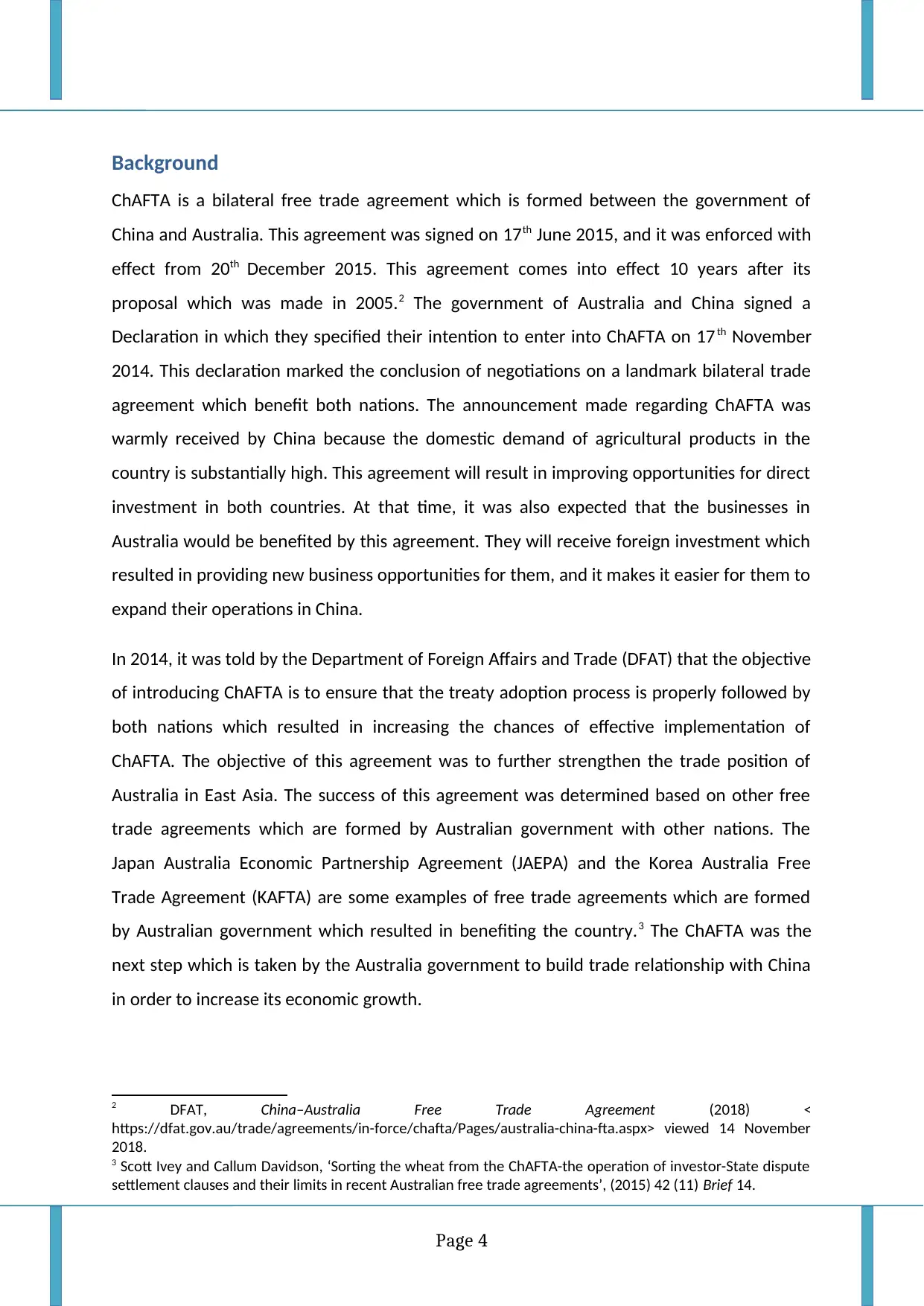
Background
ChAFTA is a bilateral free trade agreement which is formed between the government of
China and Australia. This agreement was signed on 17th June 2015, and it was enforced with
effect from 20th December 2015. This agreement comes into effect 10 years after its
proposal which was made in 2005.2 The government of Australia and China signed a
Declaration in which they specified their intention to enter into ChAFTA on 17th November
2014. This declaration marked the conclusion of negotiations on a landmark bilateral trade
agreement which benefit both nations. The announcement made regarding ChAFTA was
warmly received by China because the domestic demand of agricultural products in the
country is substantially high. This agreement will result in improving opportunities for direct
investment in both countries. At that time, it was also expected that the businesses in
Australia would be benefited by this agreement. They will receive foreign investment which
resulted in providing new business opportunities for them, and it makes it easier for them to
expand their operations in China.
In 2014, it was told by the Department of Foreign Affairs and Trade (DFAT) that the objective
of introducing ChAFTA is to ensure that the treaty adoption process is properly followed by
both nations which resulted in increasing the chances of effective implementation of
ChAFTA. The objective of this agreement was to further strengthen the trade position of
Australia in East Asia. The success of this agreement was determined based on other free
trade agreements which are formed by Australian government with other nations. The
Japan Australia Economic Partnership Agreement (JAEPA) and the Korea Australia Free
Trade Agreement (KAFTA) are some examples of free trade agreements which are formed
by Australian government which resulted in benefiting the country.3 The ChAFTA was the
next step which is taken by the Australia government to build trade relationship with China
in order to increase its economic growth.
2 DFAT, China–Australia Free Trade Agreement (2018) <
https://dfat.gov.au/trade/agreements/in-force/chafta/Pages/australia-china-fta.aspx> viewed 14 November
2018.
3 Scott Ivey and Callum Davidson, ‘Sorting the wheat from the ChAFTA-the operation of investor-State dispute
settlement clauses and their limits in recent Australian free trade agreements’, (2015) 42 (11) Brief 14.
Page 4
ChAFTA is a bilateral free trade agreement which is formed between the government of
China and Australia. This agreement was signed on 17th June 2015, and it was enforced with
effect from 20th December 2015. This agreement comes into effect 10 years after its
proposal which was made in 2005.2 The government of Australia and China signed a
Declaration in which they specified their intention to enter into ChAFTA on 17th November
2014. This declaration marked the conclusion of negotiations on a landmark bilateral trade
agreement which benefit both nations. The announcement made regarding ChAFTA was
warmly received by China because the domestic demand of agricultural products in the
country is substantially high. This agreement will result in improving opportunities for direct
investment in both countries. At that time, it was also expected that the businesses in
Australia would be benefited by this agreement. They will receive foreign investment which
resulted in providing new business opportunities for them, and it makes it easier for them to
expand their operations in China.
In 2014, it was told by the Department of Foreign Affairs and Trade (DFAT) that the objective
of introducing ChAFTA is to ensure that the treaty adoption process is properly followed by
both nations which resulted in increasing the chances of effective implementation of
ChAFTA. The objective of this agreement was to further strengthen the trade position of
Australia in East Asia. The success of this agreement was determined based on other free
trade agreements which are formed by Australian government with other nations. The
Japan Australia Economic Partnership Agreement (JAEPA) and the Korea Australia Free
Trade Agreement (KAFTA) are some examples of free trade agreements which are formed
by Australian government which resulted in benefiting the country.3 The ChAFTA was the
next step which is taken by the Australia government to build trade relationship with China
in order to increase its economic growth.
2 DFAT, China–Australia Free Trade Agreement (2018) <
https://dfat.gov.au/trade/agreements/in-force/chafta/Pages/australia-china-fta.aspx> viewed 14 November
2018.
3 Scott Ivey and Callum Davidson, ‘Sorting the wheat from the ChAFTA-the operation of investor-State dispute
settlement clauses and their limits in recent Australian free trade agreements’, (2015) 42 (11) Brief 14.
Page 4

Objectives of ChAFTA
The key reason for introduction of ChAFTA was to build new trading ties with China which
resulted in supporting the economy of both nations. In order to achieve this objective, the
DFAT set various key outcomes which are targeted to be achieved by introducing this
agreement. This agreement was focused on encouraging Chinese foreign direct investment
in Australia by approving private entities to invest in non-sensitive sectors. Before the
implementation of ChAFTA, New Zealand, Japan, Korea, Chile and the United States were
the main investors in Australia which invest foreign investments in the country.4 However,
after introduction of ChAFTA, China is expected to overcome these countries in terms of
foreign investment in Australia. The Australian government wanted to attract private
Chinese businesses to invest in Australian market which resulted in supporting the economy
of both nations. Reducing the trading barriers between the two nations is another key
objective of ChAFTA.
This agreement provides major concessions to businesses operating in both nations by
removing all import tariffs on agricultural products in Australia. Tariffs on a wide range of
Australian energy and resources products which are exported to China have also been
reduced and removed under this agreement. Pharmaceutical and manufacturing is the third
sector which has gained advantage of ChAFTA. To protect trading relationships and avoid
barriers, the government has removed all tariffs from health, vitamins and pharmaceutical
products which provide new business opportunities to Australia corporations to expand
their operations into Chinese market.5 Moreover, barriers have been removed in the service
sector by the government which has benefited key industries which include financial service,
telecommunications and technical services. To underline the main objective, ChAFTA is
focused on supporting and promoting the economic growth of both nations by removing
trade barriers which provide new business opportunities to organisations which allow them
to expand their operations in other markets easily.
4 Allens, Focus: The China-Australia Free Trade Agreement (2014)
<https://www.allens.com.au/pubs/asia/foasia21nov14.htm> viewed 14 November 2018.
5 William Van Caenegem and Jen Cleary, The importance of place: Geographical indications as a tool for local
and regional development (Springer, 2017).
Page 5
The key reason for introduction of ChAFTA was to build new trading ties with China which
resulted in supporting the economy of both nations. In order to achieve this objective, the
DFAT set various key outcomes which are targeted to be achieved by introducing this
agreement. This agreement was focused on encouraging Chinese foreign direct investment
in Australia by approving private entities to invest in non-sensitive sectors. Before the
implementation of ChAFTA, New Zealand, Japan, Korea, Chile and the United States were
the main investors in Australia which invest foreign investments in the country.4 However,
after introduction of ChAFTA, China is expected to overcome these countries in terms of
foreign investment in Australia. The Australian government wanted to attract private
Chinese businesses to invest in Australian market which resulted in supporting the economy
of both nations. Reducing the trading barriers between the two nations is another key
objective of ChAFTA.
This agreement provides major concessions to businesses operating in both nations by
removing all import tariffs on agricultural products in Australia. Tariffs on a wide range of
Australian energy and resources products which are exported to China have also been
reduced and removed under this agreement. Pharmaceutical and manufacturing is the third
sector which has gained advantage of ChAFTA. To protect trading relationships and avoid
barriers, the government has removed all tariffs from health, vitamins and pharmaceutical
products which provide new business opportunities to Australia corporations to expand
their operations into Chinese market.5 Moreover, barriers have been removed in the service
sector by the government which has benefited key industries which include financial service,
telecommunications and technical services. To underline the main objective, ChAFTA is
focused on supporting and promoting the economic growth of both nations by removing
trade barriers which provide new business opportunities to organisations which allow them
to expand their operations in other markets easily.
4 Allens, Focus: The China-Australia Free Trade Agreement (2014)
<https://www.allens.com.au/pubs/asia/foasia21nov14.htm> viewed 14 November 2018.
5 William Van Caenegem and Jen Cleary, The importance of place: Geographical indications as a tool for local
and regional development (Springer, 2017).
Page 5
⊘ This is a preview!⊘
Do you want full access?
Subscribe today to unlock all pages.

Trusted by 1+ million students worldwide
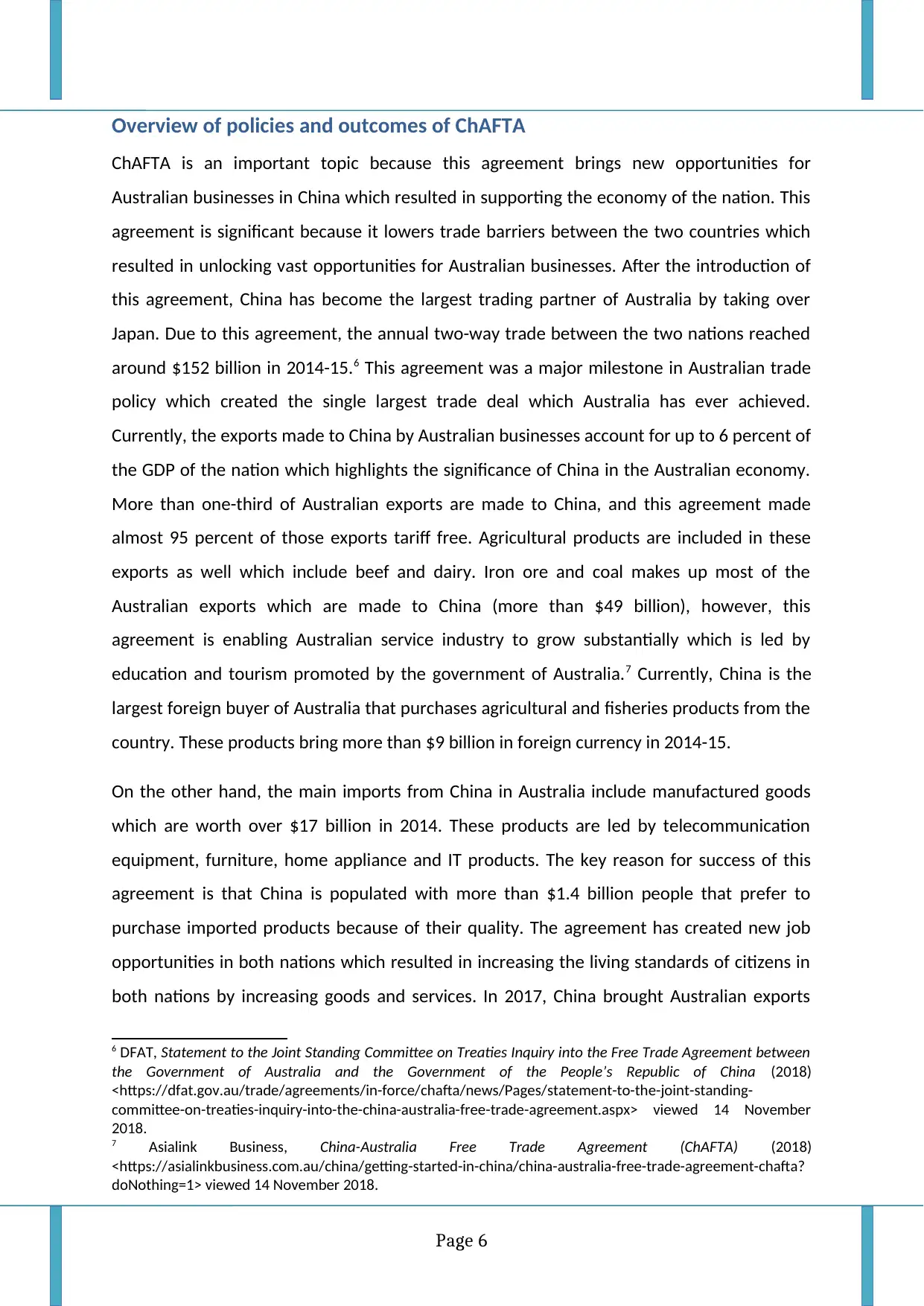
Overview of policies and outcomes of ChAFTA
ChAFTA is an important topic because this agreement brings new opportunities for
Australian businesses in China which resulted in supporting the economy of the nation. This
agreement is significant because it lowers trade barriers between the two countries which
resulted in unlocking vast opportunities for Australian businesses. After the introduction of
this agreement, China has become the largest trading partner of Australia by taking over
Japan. Due to this agreement, the annual two-way trade between the two nations reached
around $152 billion in 2014-15.6 This agreement was a major milestone in Australian trade
policy which created the single largest trade deal which Australia has ever achieved.
Currently, the exports made to China by Australian businesses account for up to 6 percent of
the GDP of the nation which highlights the significance of China in the Australian economy.
More than one-third of Australian exports are made to China, and this agreement made
almost 95 percent of those exports tariff free. Agricultural products are included in these
exports as well which include beef and dairy. Iron ore and coal makes up most of the
Australian exports which are made to China (more than $49 billion), however, this
agreement is enabling Australian service industry to grow substantially which is led by
education and tourism promoted by the government of Australia.7 Currently, China is the
largest foreign buyer of Australia that purchases agricultural and fisheries products from the
country. These products bring more than $9 billion in foreign currency in 2014-15.
On the other hand, the main imports from China in Australia include manufactured goods
which are worth over $17 billion in 2014. These products are led by telecommunication
equipment, furniture, home appliance and IT products. The key reason for success of this
agreement is that China is populated with more than $1.4 billion people that prefer to
purchase imported products because of their quality. The agreement has created new job
opportunities in both nations which resulted in increasing the living standards of citizens in
both nations by increasing goods and services. In 2017, China brought Australian exports
6 DFAT, Statement to the Joint Standing Committee on Treaties Inquiry into the Free Trade Agreement between
the Government of Australia and the Government of the People’s Republic of China (2018)
<https://dfat.gov.au/trade/agreements/in-force/chafta/news/Pages/statement-to-the-joint-standing-
committee-on-treaties-inquiry-into-the-china-australia-free-trade-agreement.aspx> viewed 14 November
2018.
7 Asialink Business, China-Australia Free Trade Agreement (ChAFTA) (2018)
<https://asialinkbusiness.com.au/china/getting-started-in-china/china-australia-free-trade-agreement-chafta?
doNothing=1> viewed 14 November 2018.
Page 6
ChAFTA is an important topic because this agreement brings new opportunities for
Australian businesses in China which resulted in supporting the economy of the nation. This
agreement is significant because it lowers trade barriers between the two countries which
resulted in unlocking vast opportunities for Australian businesses. After the introduction of
this agreement, China has become the largest trading partner of Australia by taking over
Japan. Due to this agreement, the annual two-way trade between the two nations reached
around $152 billion in 2014-15.6 This agreement was a major milestone in Australian trade
policy which created the single largest trade deal which Australia has ever achieved.
Currently, the exports made to China by Australian businesses account for up to 6 percent of
the GDP of the nation which highlights the significance of China in the Australian economy.
More than one-third of Australian exports are made to China, and this agreement made
almost 95 percent of those exports tariff free. Agricultural products are included in these
exports as well which include beef and dairy. Iron ore and coal makes up most of the
Australian exports which are made to China (more than $49 billion), however, this
agreement is enabling Australian service industry to grow substantially which is led by
education and tourism promoted by the government of Australia.7 Currently, China is the
largest foreign buyer of Australia that purchases agricultural and fisheries products from the
country. These products bring more than $9 billion in foreign currency in 2014-15.
On the other hand, the main imports from China in Australia include manufactured goods
which are worth over $17 billion in 2014. These products are led by telecommunication
equipment, furniture, home appliance and IT products. The key reason for success of this
agreement is that China is populated with more than $1.4 billion people that prefer to
purchase imported products because of their quality. The agreement has created new job
opportunities in both nations which resulted in increasing the living standards of citizens in
both nations by increasing goods and services. In 2017, China brought Australian exports
6 DFAT, Statement to the Joint Standing Committee on Treaties Inquiry into the Free Trade Agreement between
the Government of Australia and the Government of the People’s Republic of China (2018)
<https://dfat.gov.au/trade/agreements/in-force/chafta/news/Pages/statement-to-the-joint-standing-
committee-on-treaties-inquiry-into-the-china-australia-free-trade-agreement.aspx> viewed 14 November
2018.
7 Asialink Business, China-Australia Free Trade Agreement (ChAFTA) (2018)
<https://asialinkbusiness.com.au/china/getting-started-in-china/china-australia-free-trade-agreement-chafta?
doNothing=1> viewed 14 November 2018.
Page 6
Paraphrase This Document
Need a fresh take? Get an instant paraphrase of this document with our AI Paraphraser
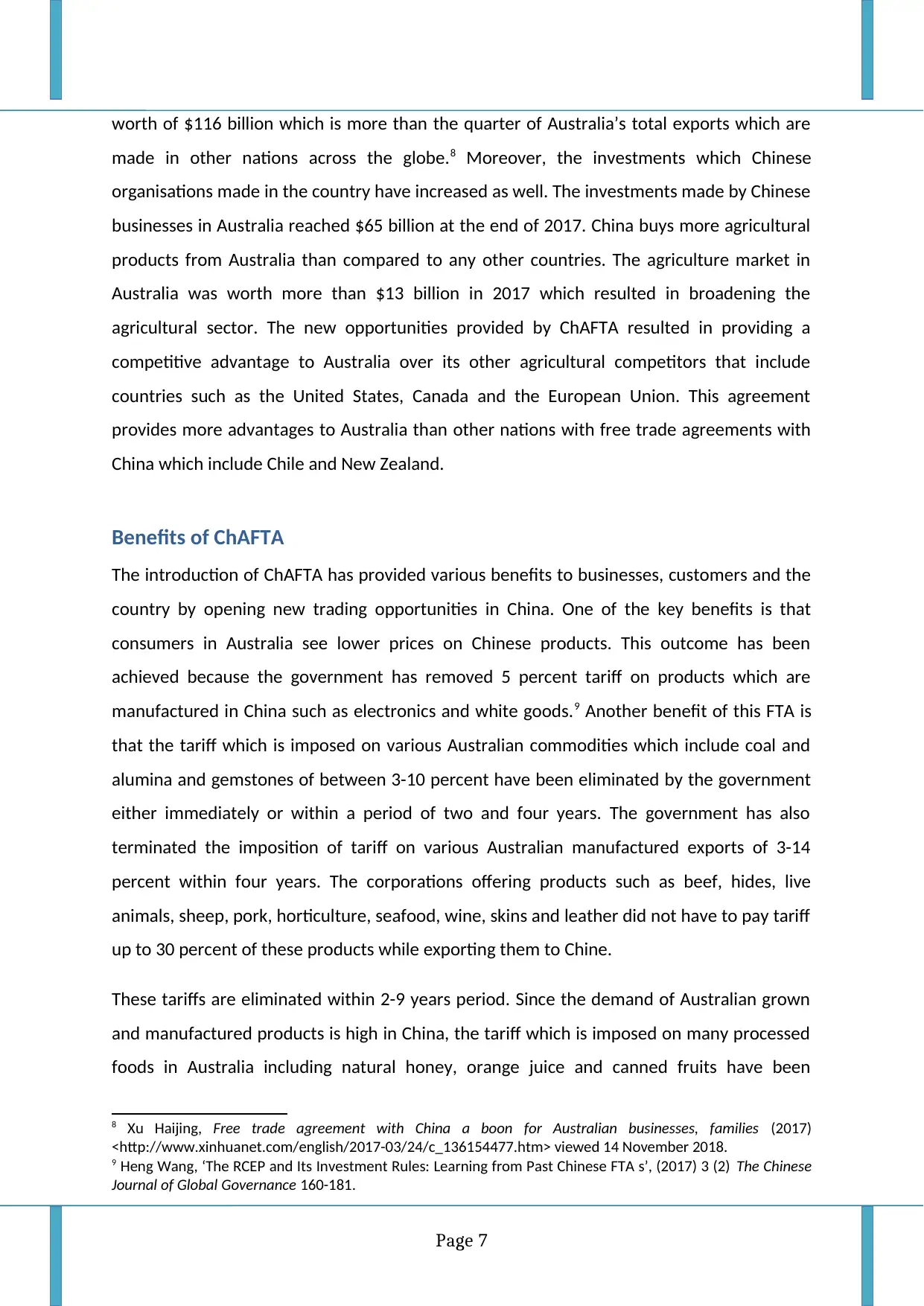
worth of $116 billion which is more than the quarter of Australia’s total exports which are
made in other nations across the globe.8 Moreover, the investments which Chinese
organisations made in the country have increased as well. The investments made by Chinese
businesses in Australia reached $65 billion at the end of 2017. China buys more agricultural
products from Australia than compared to any other countries. The agriculture market in
Australia was worth more than $13 billion in 2017 which resulted in broadening the
agricultural sector. The new opportunities provided by ChAFTA resulted in providing a
competitive advantage to Australia over its other agricultural competitors that include
countries such as the United States, Canada and the European Union. This agreement
provides more advantages to Australia than other nations with free trade agreements with
China which include Chile and New Zealand.
Benefits of ChAFTA
The introduction of ChAFTA has provided various benefits to businesses, customers and the
country by opening new trading opportunities in China. One of the key benefits is that
consumers in Australia see lower prices on Chinese products. This outcome has been
achieved because the government has removed 5 percent tariff on products which are
manufactured in China such as electronics and white goods.9 Another benefit of this FTA is
that the tariff which is imposed on various Australian commodities which include coal and
alumina and gemstones of between 3-10 percent have been eliminated by the government
either immediately or within a period of two and four years. The government has also
terminated the imposition of tariff on various Australian manufactured exports of 3-14
percent within four years. The corporations offering products such as beef, hides, live
animals, sheep, pork, horticulture, seafood, wine, skins and leather did not have to pay tariff
up to 30 percent of these products while exporting them to Chine.
These tariffs are eliminated within 2-9 years period. Since the demand of Australian grown
and manufactured products is high in China, the tariff which is imposed on many processed
foods in Australia including natural honey, orange juice and canned fruits have been
8 Xu Haijing, Free trade agreement with China a boon for Australian businesses, families (2017)
<http://www.xinhuanet.com/english/2017-03/24/c_136154477.htm> viewed 14 November 2018.
9 Heng Wang, ‘The RCEP and Its Investment Rules: Learning from Past Chinese FTA s’, (2017) 3 (2) The Chinese
Journal of Global Governance 160-181.
Page 7
made in other nations across the globe.8 Moreover, the investments which Chinese
organisations made in the country have increased as well. The investments made by Chinese
businesses in Australia reached $65 billion at the end of 2017. China buys more agricultural
products from Australia than compared to any other countries. The agriculture market in
Australia was worth more than $13 billion in 2017 which resulted in broadening the
agricultural sector. The new opportunities provided by ChAFTA resulted in providing a
competitive advantage to Australia over its other agricultural competitors that include
countries such as the United States, Canada and the European Union. This agreement
provides more advantages to Australia than other nations with free trade agreements with
China which include Chile and New Zealand.
Benefits of ChAFTA
The introduction of ChAFTA has provided various benefits to businesses, customers and the
country by opening new trading opportunities in China. One of the key benefits is that
consumers in Australia see lower prices on Chinese products. This outcome has been
achieved because the government has removed 5 percent tariff on products which are
manufactured in China such as electronics and white goods.9 Another benefit of this FTA is
that the tariff which is imposed on various Australian commodities which include coal and
alumina and gemstones of between 3-10 percent have been eliminated by the government
either immediately or within a period of two and four years. The government has also
terminated the imposition of tariff on various Australian manufactured exports of 3-14
percent within four years. The corporations offering products such as beef, hides, live
animals, sheep, pork, horticulture, seafood, wine, skins and leather did not have to pay tariff
up to 30 percent of these products while exporting them to Chine.
These tariffs are eliminated within 2-9 years period. Since the demand of Australian grown
and manufactured products is high in China, the tariff which is imposed on many processed
foods in Australia including natural honey, orange juice and canned fruits have been
8 Xu Haijing, Free trade agreement with China a boon for Australian businesses, families (2017)
<http://www.xinhuanet.com/english/2017-03/24/c_136154477.htm> viewed 14 November 2018.
9 Heng Wang, ‘The RCEP and Its Investment Rules: Learning from Past Chinese FTA s’, (2017) 3 (2) The Chinese
Journal of Global Governance 160-181.
Page 7
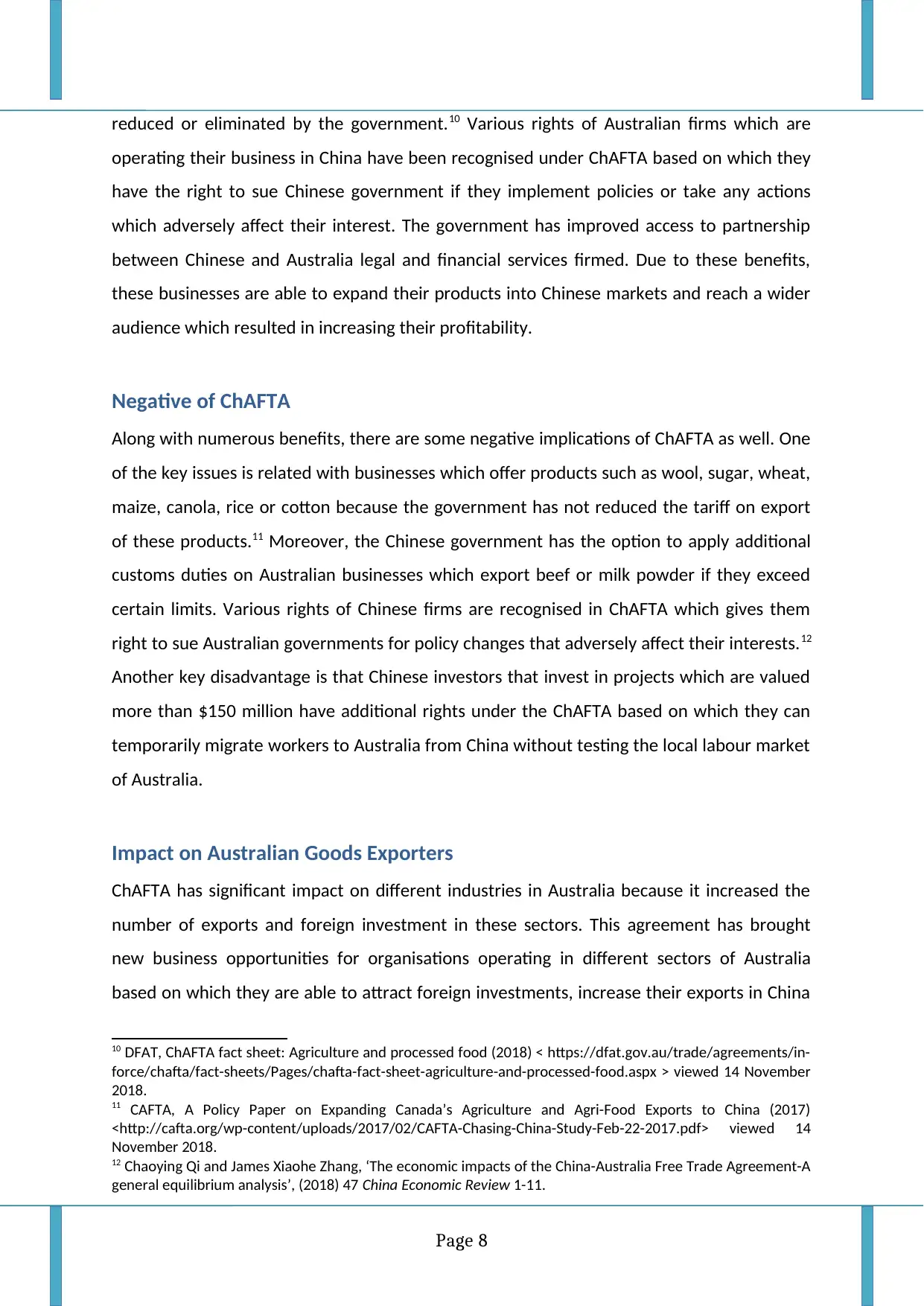
reduced or eliminated by the government.10 Various rights of Australian firms which are
operating their business in China have been recognised under ChAFTA based on which they
have the right to sue Chinese government if they implement policies or take any actions
which adversely affect their interest. The government has improved access to partnership
between Chinese and Australia legal and financial services firmed. Due to these benefits,
these businesses are able to expand their products into Chinese markets and reach a wider
audience which resulted in increasing their profitability.
Negative of ChAFTA
Along with numerous benefits, there are some negative implications of ChAFTA as well. One
of the key issues is related with businesses which offer products such as wool, sugar, wheat,
maize, canola, rice or cotton because the government has not reduced the tariff on export
of these products.11 Moreover, the Chinese government has the option to apply additional
customs duties on Australian businesses which export beef or milk powder if they exceed
certain limits. Various rights of Chinese firms are recognised in ChAFTA which gives them
right to sue Australian governments for policy changes that adversely affect their interests.12
Another key disadvantage is that Chinese investors that invest in projects which are valued
more than $150 million have additional rights under the ChAFTA based on which they can
temporarily migrate workers to Australia from China without testing the local labour market
of Australia.
Impact on Australian Goods Exporters
ChAFTA has significant impact on different industries in Australia because it increased the
number of exports and foreign investment in these sectors. This agreement has brought
new business opportunities for organisations operating in different sectors of Australia
based on which they are able to attract foreign investments, increase their exports in China
10 DFAT, ChAFTA fact sheet: Agriculture and processed food (2018) < https://dfat.gov.au/trade/agreements/in-
force/chafta/fact-sheets/Pages/chafta-fact-sheet-agriculture-and-processed-food.aspx > viewed 14 November
2018.
11 CAFTA, A Policy Paper on Expanding Canada’s Agriculture and Agri-Food Exports to China (2017)
<http://cafta.org/wp-content/uploads/2017/02/CAFTA-Chasing-China-Study-Feb-22-2017.pdf> viewed 14
November 2018.
12 Chaoying Qi and James Xiaohe Zhang, ‘The economic impacts of the China-Australia Free Trade Agreement-A
general equilibrium analysis’, (2018) 47 China Economic Review 1-11.
Page 8
operating their business in China have been recognised under ChAFTA based on which they
have the right to sue Chinese government if they implement policies or take any actions
which adversely affect their interest. The government has improved access to partnership
between Chinese and Australia legal and financial services firmed. Due to these benefits,
these businesses are able to expand their products into Chinese markets and reach a wider
audience which resulted in increasing their profitability.
Negative of ChAFTA
Along with numerous benefits, there are some negative implications of ChAFTA as well. One
of the key issues is related with businesses which offer products such as wool, sugar, wheat,
maize, canola, rice or cotton because the government has not reduced the tariff on export
of these products.11 Moreover, the Chinese government has the option to apply additional
customs duties on Australian businesses which export beef or milk powder if they exceed
certain limits. Various rights of Chinese firms are recognised in ChAFTA which gives them
right to sue Australian governments for policy changes that adversely affect their interests.12
Another key disadvantage is that Chinese investors that invest in projects which are valued
more than $150 million have additional rights under the ChAFTA based on which they can
temporarily migrate workers to Australia from China without testing the local labour market
of Australia.
Impact on Australian Goods Exporters
ChAFTA has significant impact on different industries in Australia because it increased the
number of exports and foreign investment in these sectors. This agreement has brought
new business opportunities for organisations operating in different sectors of Australia
based on which they are able to attract foreign investments, increase their exports in China
10 DFAT, ChAFTA fact sheet: Agriculture and processed food (2018) < https://dfat.gov.au/trade/agreements/in-
force/chafta/fact-sheets/Pages/chafta-fact-sheet-agriculture-and-processed-food.aspx > viewed 14 November
2018.
11 CAFTA, A Policy Paper on Expanding Canada’s Agriculture and Agri-Food Exports to China (2017)
<http://cafta.org/wp-content/uploads/2017/02/CAFTA-Chasing-China-Study-Feb-22-2017.pdf> viewed 14
November 2018.
12 Chaoying Qi and James Xiaohe Zhang, ‘The economic impacts of the China-Australia Free Trade Agreement-A
general equilibrium analysis’, (2018) 47 China Economic Review 1-11.
Page 8
⊘ This is a preview!⊘
Do you want full access?
Subscribe today to unlock all pages.

Trusted by 1+ million students worldwide
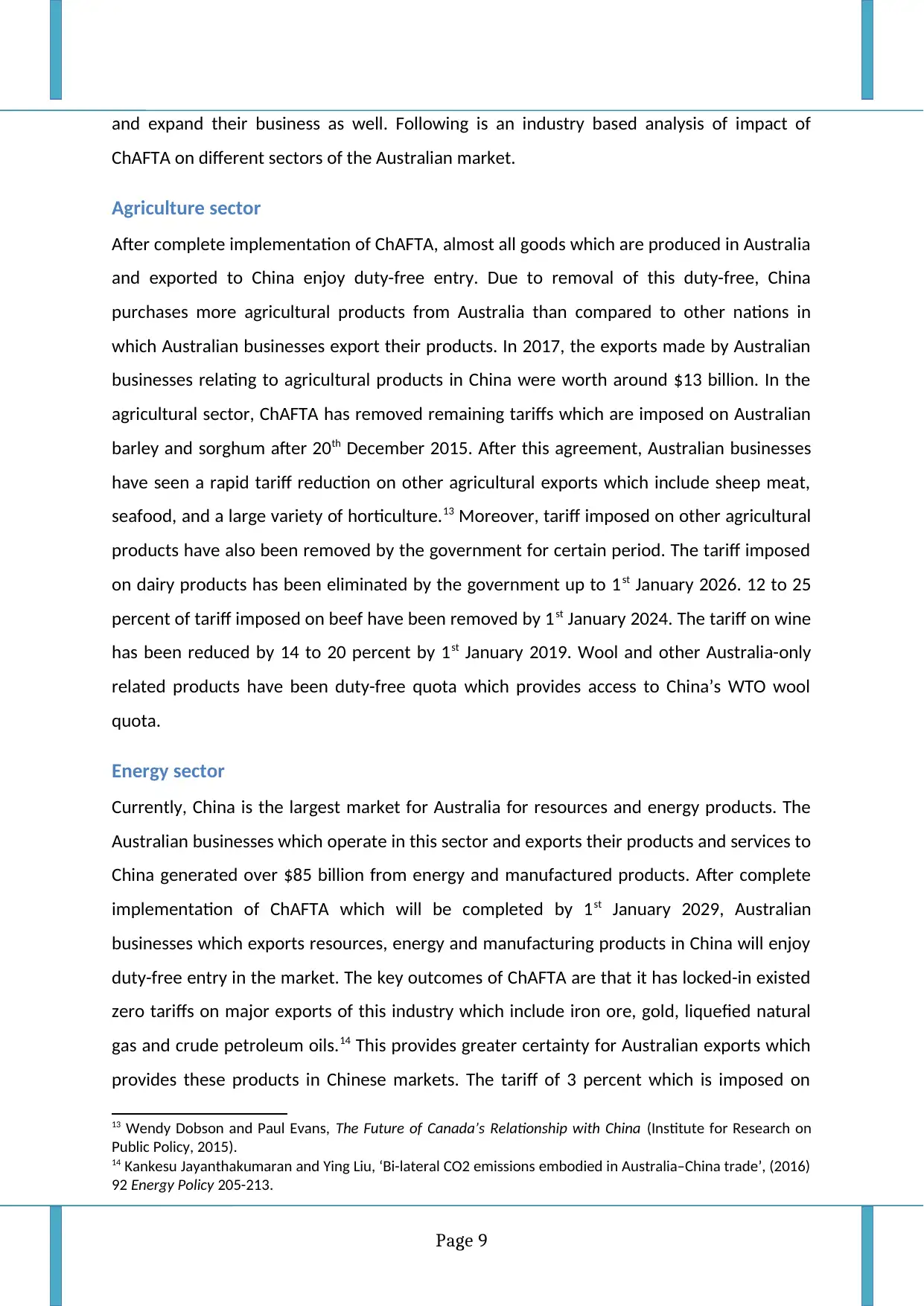
and expand their business as well. Following is an industry based analysis of impact of
ChAFTA on different sectors of the Australian market.
Agriculture sector
After complete implementation of ChAFTA, almost all goods which are produced in Australia
and exported to China enjoy duty-free entry. Due to removal of this duty-free, China
purchases more agricultural products from Australia than compared to other nations in
which Australian businesses export their products. In 2017, the exports made by Australian
businesses relating to agricultural products in China were worth around $13 billion. In the
agricultural sector, ChAFTA has removed remaining tariffs which are imposed on Australian
barley and sorghum after 20th December 2015. After this agreement, Australian businesses
have seen a rapid tariff reduction on other agricultural exports which include sheep meat,
seafood, and a large variety of horticulture.13 Moreover, tariff imposed on other agricultural
products have also been removed by the government for certain period. The tariff imposed
on dairy products has been eliminated by the government up to 1st January 2026. 12 to 25
percent of tariff imposed on beef have been removed by 1st January 2024. The tariff on wine
has been reduced by 14 to 20 percent by 1st January 2019. Wool and other Australia-only
related products have been duty-free quota which provides access to China’s WTO wool
quota.
Energy sector
Currently, China is the largest market for Australia for resources and energy products. The
Australian businesses which operate in this sector and exports their products and services to
China generated over $85 billion from energy and manufactured products. After complete
implementation of ChAFTA which will be completed by 1st January 2029, Australian
businesses which exports resources, energy and manufacturing products in China will enjoy
duty-free entry in the market. The key outcomes of ChAFTA are that it has locked-in existed
zero tariffs on major exports of this industry which include iron ore, gold, liquefied natural
gas and crude petroleum oils.14 This provides greater certainty for Australian exports which
provides these products in Chinese markets. The tariff of 3 percent which is imposed on
13 Wendy Dobson and Paul Evans, The Future of Canada’s Relationship with China (Institute for Research on
Public Policy, 2015).
14 Kankesu Jayanthakumaran and Ying Liu, ‘Bi-lateral CO2 emissions embodied in Australia–China trade’, (2016)
92 Energy Policy 205-213.
Page 9
ChAFTA on different sectors of the Australian market.
Agriculture sector
After complete implementation of ChAFTA, almost all goods which are produced in Australia
and exported to China enjoy duty-free entry. Due to removal of this duty-free, China
purchases more agricultural products from Australia than compared to other nations in
which Australian businesses export their products. In 2017, the exports made by Australian
businesses relating to agricultural products in China were worth around $13 billion. In the
agricultural sector, ChAFTA has removed remaining tariffs which are imposed on Australian
barley and sorghum after 20th December 2015. After this agreement, Australian businesses
have seen a rapid tariff reduction on other agricultural exports which include sheep meat,
seafood, and a large variety of horticulture.13 Moreover, tariff imposed on other agricultural
products have also been removed by the government for certain period. The tariff imposed
on dairy products has been eliminated by the government up to 1st January 2026. 12 to 25
percent of tariff imposed on beef have been removed by 1st January 2024. The tariff on wine
has been reduced by 14 to 20 percent by 1st January 2019. Wool and other Australia-only
related products have been duty-free quota which provides access to China’s WTO wool
quota.
Energy sector
Currently, China is the largest market for Australia for resources and energy products. The
Australian businesses which operate in this sector and exports their products and services to
China generated over $85 billion from energy and manufactured products. After complete
implementation of ChAFTA which will be completed by 1st January 2029, Australian
businesses which exports resources, energy and manufacturing products in China will enjoy
duty-free entry in the market. The key outcomes of ChAFTA are that it has locked-in existed
zero tariffs on major exports of this industry which include iron ore, gold, liquefied natural
gas and crude petroleum oils.14 This provides greater certainty for Australian exports which
provides these products in Chinese markets. The tariff of 3 percent which is imposed on
13 Wendy Dobson and Paul Evans, The Future of Canada’s Relationship with China (Institute for Research on
Public Policy, 2015).
14 Kankesu Jayanthakumaran and Ying Liu, ‘Bi-lateral CO2 emissions embodied in Australia–China trade’, (2016)
92 Energy Policy 205-213.
Page 9
Paraphrase This Document
Need a fresh take? Get an instant paraphrase of this document with our AI Paraphraser
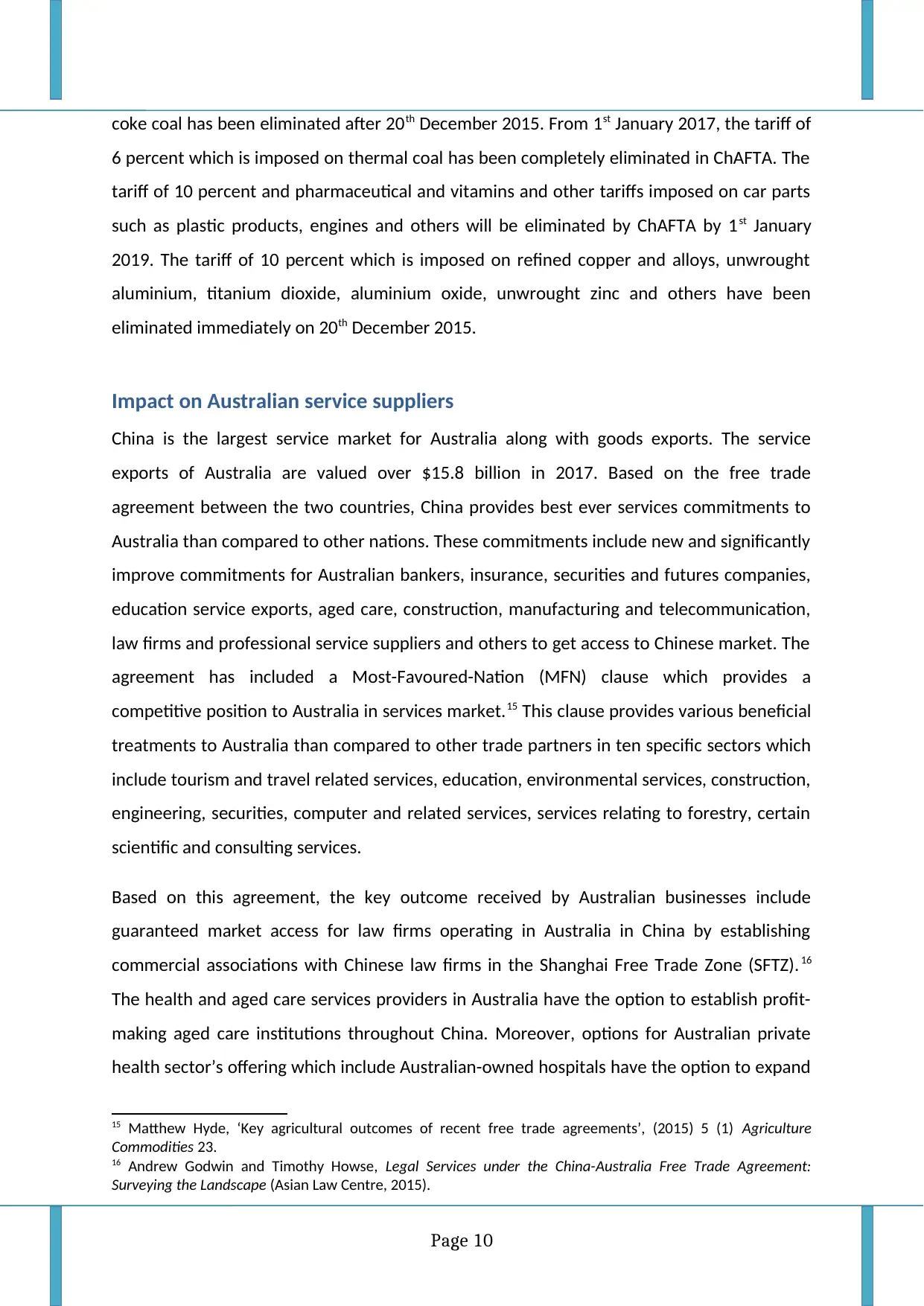
coke coal has been eliminated after 20th December 2015. From 1st January 2017, the tariff of
6 percent which is imposed on thermal coal has been completely eliminated in ChAFTA. The
tariff of 10 percent and pharmaceutical and vitamins and other tariffs imposed on car parts
such as plastic products, engines and others will be eliminated by ChAFTA by 1st January
2019. The tariff of 10 percent which is imposed on refined copper and alloys, unwrought
aluminium, titanium dioxide, aluminium oxide, unwrought zinc and others have been
eliminated immediately on 20th December 2015.
Impact on Australian service suppliers
China is the largest service market for Australia along with goods exports. The service
exports of Australia are valued over $15.8 billion in 2017. Based on the free trade
agreement between the two countries, China provides best ever services commitments to
Australia than compared to other nations. These commitments include new and significantly
improve commitments for Australian bankers, insurance, securities and futures companies,
education service exports, aged care, construction, manufacturing and telecommunication,
law firms and professional service suppliers and others to get access to Chinese market. The
agreement has included a Most-Favoured-Nation (MFN) clause which provides a
competitive position to Australia in services market.15 This clause provides various beneficial
treatments to Australia than compared to other trade partners in ten specific sectors which
include tourism and travel related services, education, environmental services, construction,
engineering, securities, computer and related services, services relating to forestry, certain
scientific and consulting services.
Based on this agreement, the key outcome received by Australian businesses include
guaranteed market access for law firms operating in Australia in China by establishing
commercial associations with Chinese law firms in the Shanghai Free Trade Zone (SFTZ).16
The health and aged care services providers in Australia have the option to establish profit-
making aged care institutions throughout China. Moreover, options for Australian private
health sector’s offering which include Australian-owned hospitals have the option to expand
15 Matthew Hyde, ‘Key agricultural outcomes of recent free trade agreements’, (2015) 5 (1) Agriculture
Commodities 23.
16 Andrew Godwin and Timothy Howse, Legal Services under the China-Australia Free Trade Agreement:
Surveying the Landscape (Asian Law Centre, 2015).
Page 10
6 percent which is imposed on thermal coal has been completely eliminated in ChAFTA. The
tariff of 10 percent and pharmaceutical and vitamins and other tariffs imposed on car parts
such as plastic products, engines and others will be eliminated by ChAFTA by 1st January
2019. The tariff of 10 percent which is imposed on refined copper and alloys, unwrought
aluminium, titanium dioxide, aluminium oxide, unwrought zinc and others have been
eliminated immediately on 20th December 2015.
Impact on Australian service suppliers
China is the largest service market for Australia along with goods exports. The service
exports of Australia are valued over $15.8 billion in 2017. Based on the free trade
agreement between the two countries, China provides best ever services commitments to
Australia than compared to other nations. These commitments include new and significantly
improve commitments for Australian bankers, insurance, securities and futures companies,
education service exports, aged care, construction, manufacturing and telecommunication,
law firms and professional service suppliers and others to get access to Chinese market. The
agreement has included a Most-Favoured-Nation (MFN) clause which provides a
competitive position to Australia in services market.15 This clause provides various beneficial
treatments to Australia than compared to other trade partners in ten specific sectors which
include tourism and travel related services, education, environmental services, construction,
engineering, securities, computer and related services, services relating to forestry, certain
scientific and consulting services.
Based on this agreement, the key outcome received by Australian businesses include
guaranteed market access for law firms operating in Australia in China by establishing
commercial associations with Chinese law firms in the Shanghai Free Trade Zone (SFTZ).16
The health and aged care services providers in Australia have the option to establish profit-
making aged care institutions throughout China. Moreover, options for Australian private
health sector’s offering which include Australian-owned hospitals have the option to expand
15 Matthew Hyde, ‘Key agricultural outcomes of recent free trade agreements’, (2015) 5 (1) Agriculture
Commodities 23.
16 Andrew Godwin and Timothy Howse, Legal Services under the China-Australia Free Trade Agreement:
Surveying the Landscape (Asian Law Centre, 2015).
Page 10
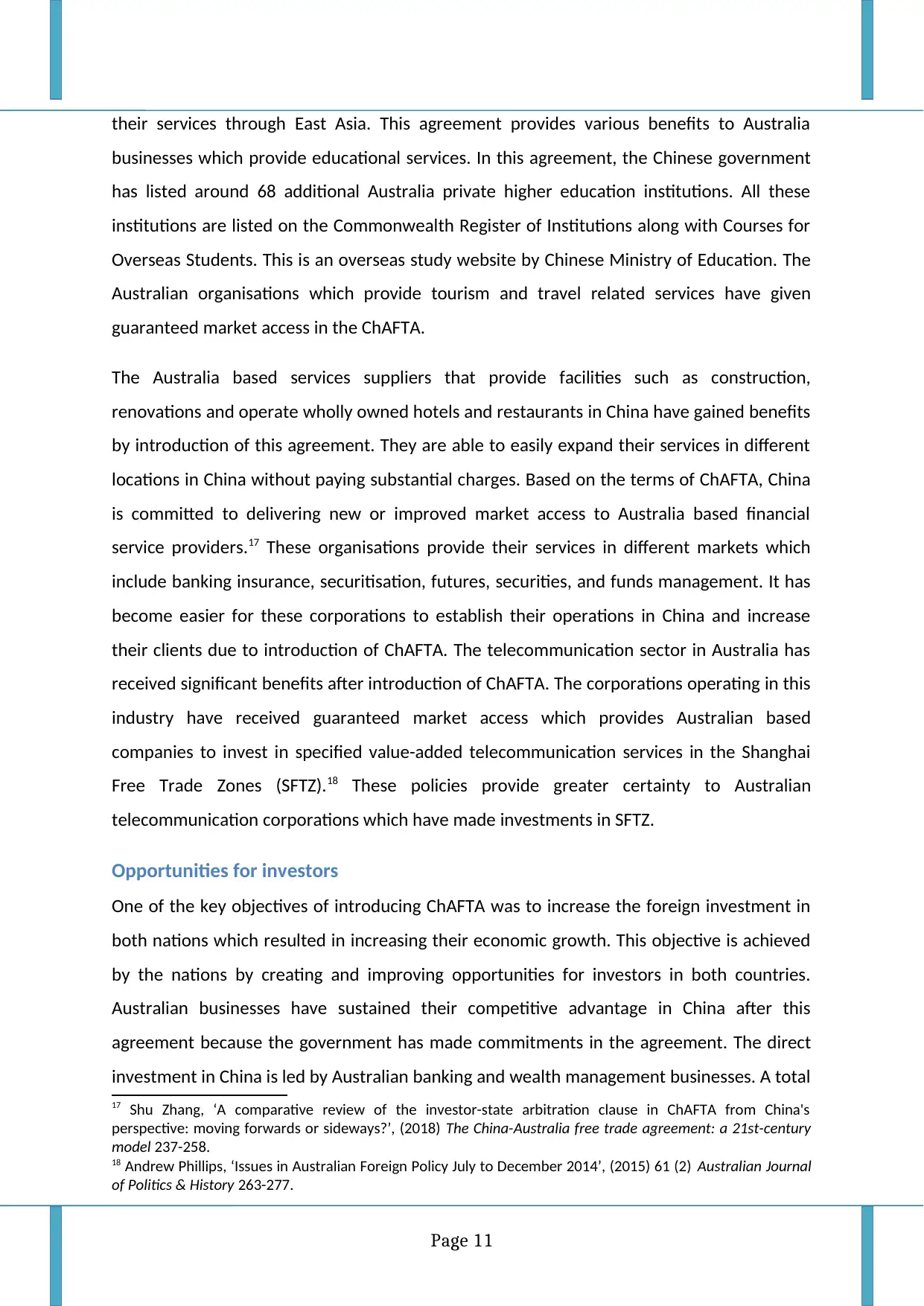
their services through East Asia. This agreement provides various benefits to Australia
businesses which provide educational services. In this agreement, the Chinese government
has listed around 68 additional Australia private higher education institutions. All these
institutions are listed on the Commonwealth Register of Institutions along with Courses for
Overseas Students. This is an overseas study website by Chinese Ministry of Education. The
Australian organisations which provide tourism and travel related services have given
guaranteed market access in the ChAFTA.
The Australia based services suppliers that provide facilities such as construction,
renovations and operate wholly owned hotels and restaurants in China have gained benefits
by introduction of this agreement. They are able to easily expand their services in different
locations in China without paying substantial charges. Based on the terms of ChAFTA, China
is committed to delivering new or improved market access to Australia based financial
service providers.17 These organisations provide their services in different markets which
include banking insurance, securitisation, futures, securities, and funds management. It has
become easier for these corporations to establish their operations in China and increase
their clients due to introduction of ChAFTA. The telecommunication sector in Australia has
received significant benefits after introduction of ChAFTA. The corporations operating in this
industry have received guaranteed market access which provides Australian based
companies to invest in specified value-added telecommunication services in the Shanghai
Free Trade Zones (SFTZ).18 These policies provide greater certainty to Australian
telecommunication corporations which have made investments in SFTZ.
Opportunities for investors
One of the key objectives of introducing ChAFTA was to increase the foreign investment in
both nations which resulted in increasing their economic growth. This objective is achieved
by the nations by creating and improving opportunities for investors in both countries.
Australian businesses have sustained their competitive advantage in China after this
agreement because the government has made commitments in the agreement. The direct
investment in China is led by Australian banking and wealth management businesses. A total
17 Shu Zhang, ‘A comparative review of the investor-state arbitration clause in ChAFTA from China's
perspective: moving forwards or sideways?’, (2018) The China-Australia free trade agreement: a 21st-century
model 237-258.
18 Andrew Phillips, ‘Issues in Australian Foreign Policy July to December 2014’, (2015) 61 (2) Australian Journal
of Politics & History 263-277.
Page 11
businesses which provide educational services. In this agreement, the Chinese government
has listed around 68 additional Australia private higher education institutions. All these
institutions are listed on the Commonwealth Register of Institutions along with Courses for
Overseas Students. This is an overseas study website by Chinese Ministry of Education. The
Australian organisations which provide tourism and travel related services have given
guaranteed market access in the ChAFTA.
The Australia based services suppliers that provide facilities such as construction,
renovations and operate wholly owned hotels and restaurants in China have gained benefits
by introduction of this agreement. They are able to easily expand their services in different
locations in China without paying substantial charges. Based on the terms of ChAFTA, China
is committed to delivering new or improved market access to Australia based financial
service providers.17 These organisations provide their services in different markets which
include banking insurance, securitisation, futures, securities, and funds management. It has
become easier for these corporations to establish their operations in China and increase
their clients due to introduction of ChAFTA. The telecommunication sector in Australia has
received significant benefits after introduction of ChAFTA. The corporations operating in this
industry have received guaranteed market access which provides Australian based
companies to invest in specified value-added telecommunication services in the Shanghai
Free Trade Zones (SFTZ).18 These policies provide greater certainty to Australian
telecommunication corporations which have made investments in SFTZ.
Opportunities for investors
One of the key objectives of introducing ChAFTA was to increase the foreign investment in
both nations which resulted in increasing their economic growth. This objective is achieved
by the nations by creating and improving opportunities for investors in both countries.
Australian businesses have sustained their competitive advantage in China after this
agreement because the government has made commitments in the agreement. The direct
investment in China is led by Australian banking and wealth management businesses. A total
17 Shu Zhang, ‘A comparative review of the investor-state arbitration clause in ChAFTA from China's
perspective: moving forwards or sideways?’, (2018) The China-Australia free trade agreement: a 21st-century
model 237-258.
18 Andrew Phillips, ‘Issues in Australian Foreign Policy July to December 2014’, (2015) 61 (2) Australian Journal
of Politics & History 263-277.
Page 11
⊘ This is a preview!⊘
Do you want full access?
Subscribe today to unlock all pages.

Trusted by 1+ million students worldwide
1 out of 18
Related Documents
Your All-in-One AI-Powered Toolkit for Academic Success.
+13062052269
info@desklib.com
Available 24*7 on WhatsApp / Email
![[object Object]](/_next/static/media/star-bottom.7253800d.svg)
Unlock your academic potential
Copyright © 2020–2025 A2Z Services. All Rights Reserved. Developed and managed by ZUCOL.





